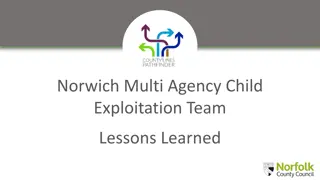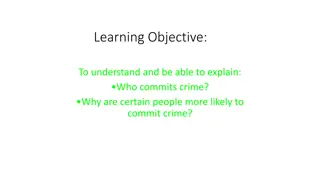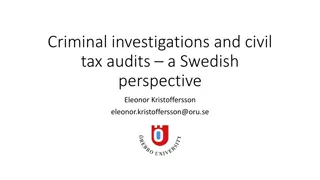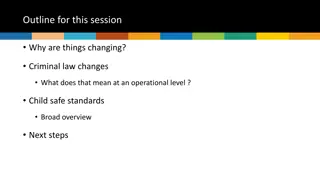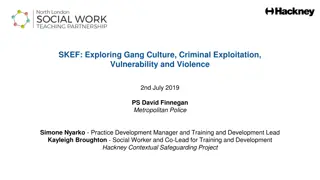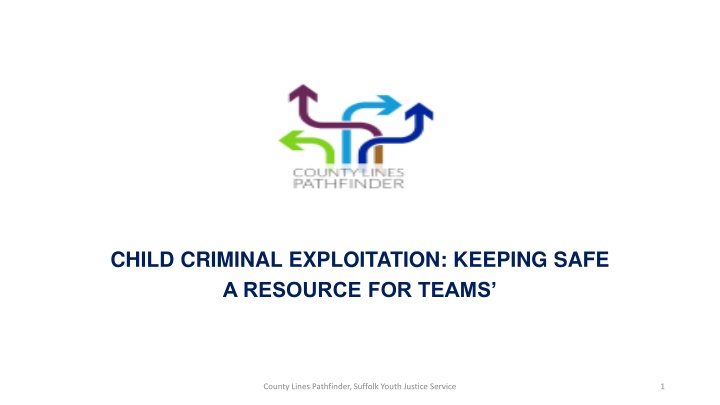
Professional Boundaries in Working Relationships
Explore the importance of maintaining clear boundaries in professional relationships to prevent burnout, ensure safety, and maintain professionalism with children and caregivers in the field of youth justice and criminal exploitation.
Download Presentation

Please find below an Image/Link to download the presentation.
The content on the website is provided AS IS for your information and personal use only. It may not be sold, licensed, or shared on other websites without obtaining consent from the author. If you encounter any issues during the download, it is possible that the publisher has removed the file from their server.
You are allowed to download the files provided on this website for personal or commercial use, subject to the condition that they are used lawfully. All files are the property of their respective owners.
The content on the website is provided AS IS for your information and personal use only. It may not be sold, licensed, or shared on other websites without obtaining consent from the author.
E N D
Presentation Transcript
CHILD CRIMINAL EXPLOITATION: KEEPING SAFE A RESOURCE FOR TEAMS County Lines Pathfinder, Suffolk Youth Justice Service 1
INTRODUCTION A core part of our work is to build and maintain good relationships with those we work with. The ability to develop trust with children who are criminally exploited is essential. In this field, some of the literature refers to professionals going above and beyond to engage children; however, it is important that expectations, standards, and boundaries are clear and that practitioners understand and can apply them. The benefits of doing this are: To prevent staff burn out . To create and maintain a safe working environment To ensure relationships remain professional with children, caregivers, and community members. To ensure that the team / service takes a consistent approach with children, caregivers and community members. To ensure that professionals work within their skill sets and the team boundaries. This tool is designed to help support a reflective conversation with your team. County Lines Pathfinder, Suffolk Youth Justice Service 2
Suffolk Youth Justice Service County Lines Pathfinder, HOPES To explore professional boundaries, and factors about the cohorts we support which may affect these. This tool will provide space to reflect on our relationships with the children and families we work with. To explore how to manage dilemmas which may arise as a result of work in this field. arise Focus on protecting ourselves and the people we work with. 3
PROFESSIONAL VS OTHER RELATIONSHIPS In contrast to other relationships we may form, working relationships tend to involve: Functional and deliberate selection Unlike our partners / friends, we do not choose who we work with Relationship is formally requested not casually developed Specific goals and purpose in mind Formal initiation, duration, and termination boundaries Clear expectations and boundaries about when the relationship starts, how long it will last, how and when it comes to an end, unlike most other forms of friendships and relationships Generally, there is a very specific reason for the relationship exiting, and this may relate to one person needing something and another being able to support the needs (clear roles recipient and provider). Goal-directed and purposeful interactions Professional emotional distance and objectivity Not emotionally involved! Hence why practitioners cannot treat people they know removes the ability to be objective and emotionally distanced. County Lines Pathfinder, Suffolk Youth Justice Service 4
PROFESSIONAL VS OTHER RELATIONSHIPS Cont. Adherence to clearly defined legal, ethical, and professional guidelines These may be generally present within society (e.g., don t murder your mates) but more clearly and specifically defined within professional relationships; care professionals expected to adhere to own professional guidance and the ethics in therapeutic relationships Confidentially (and limits to this) Legal and ethical boundaries around confidentiality vs moral boundaries. Non-judgemental positive regard Approach people we work with in a different way to how we may approach our friend, partner, or child Boundaries relating to professionals self- disclosure Relationship is not a mutual two-way relationship Strategic self-disclosure may be a feature, but carefully considered Socialising, dating, gifts etc. What do we do when we see children / families and we re off duty ? Inherent within ALL relationships between providers and recipient of care no matter how on their level you may perceive yourself to be! The absence of dual relationships Power imbalance County Lines Pathfinder, Suffolk Youth Justice Service 5
BOUNDARIES Provide a framework for creating safe and healthy relationships between professionals and clients. Protection from potential harm and exploitation - physical and emotional limits benefit both clients and practitioners. Help to keep the relationship safe and focused upon the needs of the client. The reality of the work we do is that boundaries sometimes inevitably get crossed. It is not always practical to challenge every single instance of this, so we tend to do on-going dynamic risk assessments in situations and intervene where necessary. Boundary crossings can become part of a pattern / build up of behaviour between practitioners and clients, which over time can lead to serious breaches. Our jobs, individually, and collectively is to spot these violations and take appropriate action. County Lines Pathfinder, Suffolk Youth Justice Service 6
BOUNDARIES Cont. Managing boundaries within working relationships is crucially important. Children / families damaged by violations. Practitioners careers are ended. Families of practitioners and children alike can be left devastated. Colleagues of practitioners are affected. Reputation of services and organisations is damaged, which can also affect other children / clients and how willing they are to engage with services. Ethical, moral, professional, legal implications. County Lines Pathfinder, Suffolk Youth Justice Service 7
PHYSICAL Not all psychical contact is sexual, such as putting an arm around a distressed child. Do we hug / let ourselves be hugged by children / families? Personal spaces and closeness how might this be perceived? SEXUAL Flirting, sexual attraction towards a child / caregiver as well as towards ourselves Particularly fraught in those with history of sexual abuse compulsion to recreate unhealthy / abusive dynamics within relationships DIFFERENT PROFESSIONAL BOUNDARIES INTIMATE What about intimate gestures such as sending a card / buying a gift? Personal problems, feeling about work / colleagues etc. EMOTIONAL Frequently thinking about clients when away from work Maintaining professionalism in terms of emotional expressions Getting our own emotional needs met through the work we do SELF-DISCLOSURE Sharing personal problems, aspects of own life history, who s needs are really being met in these instances? County Lines Pathfinder, Suffolk Youth Justice Service 8
FINANCIAL Receiving / giving money / goods / gifts CRIMINAL Colluding with criminal actions of YP Exploiting / perpetrating criminal acts involving others Abuse / neglect of YP / families DIFFERENT PROFESSIONAL BOUNDARIES Cont. WORKING BEYOND LIMITS OF COMPETENCY Working beyond your knowledge and skills Not seeking additional support or transferring a case when you need to DUAL- RELATIONSHIPS Seeing children outside of work Friendships, romantic relationships, social media, neighbours, friends, connected within local community FITNESS TO PRACTICE Potential impact of our own emotional wellbeing and mental health upon child County Lines Pathfinder, Suffolk Youth Justice Service 9
SECRETIVE / SELECTIVE BEHAVIOUR Only reporting certain aspects of a child s behaviours (e.g., paint in a positive light) Not discussing aspects of the work with others Intentionally keeping aspects of the relationship secret from others SPECIAL TREATMENT DIFFERENT PROFESSIONAL BOUNDARIES Cont. Proving preferential treatment / going the extra mile for some children Conversely, withholding treatment from less likeable children CONSISTENCY AND SERVICE OBLIGATIONS Appointment frequency who in your caseload do you want to see more / less of, what does this say about your boundaries with both? RESCUING Feeling pulled into rescuing certain client removing autonomy and choice, disempowering, gratifying own needs to feel powerful and competent. County Lines Pathfinder, Suffolk Youth Justice Service 10
CONTINUUM OF INAPPROPRIATE BEHAVIOURS Boundary crossing Boundary violation Professional misconduct Boundary Crossing: May be considered generally harmless? Could be therapeutic? Sometimes acceptable? BUT potential to lead to more serious violations. Boundary Violation: Not considered to be therapeutic / constructive; can be exploitative. Self-centred purpose. Has the potential to cause harm. Professional misconduct: Serious, forbidden, or illegal behaviour which has the potential to cause harm. County Lines Pathfinder, Suffolk Youth Justice Service 11
Small stuff matters and you can drift towards professional misconduct. Serious boundary violations tend to occur less often as one off events, and more frequently after a process of gradual boundary erosion over time. County Lines Pathfinder, Suffolk Youth Justice Service 12
Not exhaustive, but research would suggest certain factors increase the risk of violations occurring, such factors include: Lack of experience (but also high experience too, believing your judgement is right all the time) Anxiety Social / professional isolation High levels of impulsivity RISK AND VULNERABILITY FACTORS Low self-esteem Own histories of trauma / attachment related issues Unresolved anger towards authority figures Difficulties with not being liked by clients High levels of stress / high risk work environment Lack of accountability Perceived insufficient emotional support Rarely, mental illness (e.g. mania, psychosis, personality disorders- ASPD, Narcissistic PD- god complex ) Factors associated with work settings (e.g. isolated working practices) Client type and what they may bring to relationship dynamics County Lines Pathfinder, Suffolk Youth Justice Service 13
BUT organisational / systemic factors can also play a role, e.g. Winterbourne "A culture of ill-treatment developed Managers and regulators bear a responsibility for creating and sustaining the professional cultures within which boundary violations occur (Council for Healthcare Regulatory Excellence, 2007) Rather than a simple bad apple model, an alternative view is that all practitioners should be aware of their trouble spots around boundary issues. (Council for Healthcare Regulatory Excellence, 2007) Ethical engagement- how often are professional boundary dilemmas regularly discussed & addressed as part of everyday practice within teams / services? Factors that are related to cohorts that could make managing boundaries more challenging or present more dilemmas. Being pulled into rescuer / persecutor / victim roles. Pressure to perform and get the job done Pressures to engage child / families who are hard to engage going the extra mile . Very high levels of risk at times - doing what needs to be done to manage this . Sexual exploitation: Association between CSA and subsequent abuse / challenges in managing close relationships, dynamics and dilemmas, tricky for even the most experienced practitioners. County Lines Pathfinder, Suffolk Youth Justice Service 14
Criminal exploitation: mistrustful, working hard to engage, re- treading familiar relationship patterns and dynamics. FACTORS THAT ARE RELATED TO COHORTS THAT COULD MAKE MANAGING BOUNDARIES MORE CHALLENGING OR PRESENT MORE DILEMMAS Empathy hearing too many gut-wrenching and sad stories, trying to fix this. Myths and misconceptions- believe we need to self-disclose to engage. Narratives around the cohorts- needing to be a safe and trusted adult - connected to local community, but this creates ethical dilemmas of working with children related to adults we might know from other contexts. Risks related to child s networks- every time you share something with a child you are sharing this information potentially with every person they know, and every individual all those other people know too Victim / perpetrator dichotomy failing to appreciate the potential for harm. County Lines Pathfinder, Suffolk Youth Justice Service 15
Evidence base would suggest effective therapeutic relationships with people who have experienced significant abuse and/or who may be involved in anti-social or offending behaviour require a strong and boundaried attachment relationship between the practitioner and offender. (NOMS & NHS England, 2015). Balance between caring too much or being punitive. Becoming the: over caring mother PRACTITIONER GUIDANCE: punitive father figure mates (esp. for younger staff) Showing you care in a boundaried way- all children will challenge boundaries, when this natural tendency is combined with histories of relational trauma and/or exploitation, dynamics can be particularly challenging to manage. Importance of not getting drawn into revealing personal facts as a way to establish intimacy (NOMS & NHS England, 2015). County Lines Pathfinder, Suffolk Youth Justice Service 16
WHAT COULD YOU OR OTHERS START TO NOTICE WHEN THINGS START TO DRIFT? Increased frequency of actual / attempted small boundary crossings (by self, or client). Case drift- topics of conversation stray frequently / prolonged period off focus of work. Keeping secrets with clients or omitting information from colleagues / managers. Instances of self-disclosure (particularly without reflection / reflexive consideration). Believing that you understand the client better than anyone else / you feel strongly emotionally connected to them. Discussing issues with clients which are out of your scope of practice. Selective reporting of information, e.g., to colleagues, manager etc. Feelings of us vs. everyone else Times when you do things differently with particular client(s), e.g., offer more appointments, greater flexibility, things which for you are out of character. Feeling unable to discuss certain aspects of your work with supervisors / colleagues. Feeling the urge to rescue and fix clients, or similarly reject. Overly protective or defensive behaviour about the client County Lines Pathfinder, Suffolk Youth Justice Service 17
How to keep ourselves and the children / caregivers we work with, safe in our relationships Being aware of our own histories and vulnerabilities and reflecting on how this may affect the way in which we engage and manage relationships with other people. Points for reflection might include: What has motivated us to want to do this work? What clients do we tend to identify strongly with? Which do we not? Why? How does this affect the way we work with these groups? How might factors from our past influence how we view relationships with vulnerable children and families? What messages and information do we intentionally and unintentionally give off about ourselves? How might this be perceived by children / families? CREATING SAFER RELATIONSHIPS Whose need am I meeting right now? Noticing when you strongly disagree with thoughts / views / opinions of supervisors, managers, colleagues and reflecting on why this might be are they really wrong, or are you rationalising / justifying your position? Keeping a healthy degree of scepticism / cynicism- holding in mind both perpetrator and victim status. Trusting your instincts- that feeling that something just isn t right Self-monitoring nature of the relationship (e.g., do you come away from sessions feeling special ? as though the work s going really well? This can be a warning sign!) Placing the child and family within context- awareness of the whole network. Challenging one another safely. County Lines Pathfinder, Suffolk Youth Justice Service 18
ESTABLISHING HEALTHIER BOUNDARIES Sometimes there are particular thoughts and beliefs which inform the way in which we feel and therefore behave within our professional (and personal) relationships. Identifying and working on modifying these thoughts and beliefs can therefore influence how we then feel and how we therefore act. County Lines Pathfinder, Suffolk Youth Justice Service 19
We may hold particular beliefs which influence our vulnerabilities and professional boundaries with children and families, such as: Switching from: To: If I don t find a way of engaging them, I m a poor worker If I don t find a way to make them like me quick, they won t engage, and will be at risk I am responsible for this child s safety If this child goes on to offend again, this will reflect badly on me personally They ve had such an awful life; I must make sure I m always kind to them I can t criticise or tell them off, they ve had such an awful life so far These children are all the same, there s no way anything I do will make a difference, why bother? Thoughts I am responsible for what happens to this child Feelings Anxious, fearful, overwhelmed, defensive, pressure Actions Working above and beyond , being overly flexible, rescuing , defensive practices, boundary crossing to increase engagement Thoughts I m responsible for doing the best jobs I m capable of doing to support this child Feelings Competent, proficient, calm Actions: Working within limits of competency, asking for help when needed, bringing dilemmas to supervision, noticing violations of boundaries and discussing these concerns. Sharing concerns but and not becoming overwhelmed by them
SCENARIOS: TEAM DISCUSSIONS Below are some examples of how scenarios could be used to generate team discussions. By discussing made up scenarios, it provides an opportunity to share different opinions and consider how, as a team, they can be resolved. County Lines Pathfinder, Suffolk Youth Justice Service 21
Scenario 1 Your manager has asked Alex to work with a child. Alex goes to meet the child and then later realise that she knows their older brother (Ron) from when they were at school together. Alex and Ron used to be good friends and previously socialised together. Alex and Ron are friends on social media (and have a lot of mutual friends), but they haven t seen or spoken to each other in years. What should Alex do? 1. Should she ask for another worker? What would be the advantages and disadvantages of doing this? What is behind your thinking on this? What should Alex do if Ron hasn t made the connection that he knows Alex? Should Alex continue to work with the child? What if Ron made the connection later would that change things? 2. How should Alex manage the issue of social media? Should she keep Ron on her social media or remove / block him? What about if they had mutual friends that post things that include Alex? For example, pictures of her from a social event. What if Ron posts things (or is tagged in) posts which suggests some criminality? For example, a picture of Ron smoking what looks like cannabis and holding a large sum of money. 3. How should Alex manage things if she bumps into Ron socially? Should she ignore him? What would be the advantages and disadvantages of this? If they speak, what she do if he starts to quiz her about her role? What if he asks about how his younger sibling is getting on? Can you think of any ways that Alex could shut down a conversation with Ron without causing offence? County Lines Pathfinder, Suffolk Youth Justice Service 22
Scenario 2 It is the weekend; Shannon is at a BBQ with some friends. She sees a group who look familiar. One of Shannon s single friends shares her number with one of the group. Shannon later finds out from attending a professionals meeting that this person is known to the police for drug supply and exploiting children. This person is now dating Shannon s friend, who doesn t appear to know this information. What should Shannon do? 1. Should she tell her friend? What would be the advantages and disadvantages of this? What should she do if her friends begin to invite this person to the same events that Shannon will be at? 2. Should Shannon tell her manager? What would you hope the manager suggests to her? 3. Could this person mixing in Shannon s social circles cause her any difficulties? How could she manage this? 4. What should Shannon do if she saw a child talking to this person? 5. What should Shannon do if this person started quizzing her about your job? County Lines Pathfinder, Suffolk Youth Justice Service 23
Scenario 3 Ahmed has been trying to engage a child for some time. Services are very worried about this child and are deeply concerned for their safety. Lots of professionals have tried to engage the child but have been unsuccessful. The child arrives for Ahmed s meeting and appear to be in a talkative mood, sharing things that have happened and how they feel. It then dawns on Ahmed that they are under the influence of drugs. What should Ahmed do? 1. Should he stop the session or let it carry on? What would be the advantages and disadvantages of both? How might the child respond if Ahmed stops or allows the session to continue? 2. In what ways do you think Ahmed may feel pressure to engage this child? How could that pressure present itself? 3. Could it concern Ahmed that he may have lost a golden opportunity with the child? If so, would steps could he take to try and pull it back? What agencies should Armed share his concerns that the child was under the influence of drugs? What impact could 4. this have on the relationship between Ahmed and the child? What steps could Ahmed take to try and reduce any negative fall out from sharing the information? County Lines Pathfinder, Suffolk Youth Justice Service 24
Scenario 4 Ernest is a child professionals are worried about His home life is unsettled, and he doesn t appear to have a supportive network around him. Ernest often goes missing and returns looking disheveled. Ernest has a good relationship with Amanda, his YOT worker. He calls her one Friday night, whilst he is currently missing. Amanda forgot to turn her phone off after she finished work and can now hear it ringing. What should Amanda do? 1. Should she answer the phone? What would be the advantages and disadvantages of this? 2. What could be the consequences? 3. How could answering the phone after finishing work, impact on the rest of the team? County Lines Pathfinder, Suffolk Youth Justice Service 25
Ensure you are aware of your organisations policies: o Code of Conduct o Social Media Policy o Lone Working Policy o Conflict of Interest Policy o Safeguarding o Whistleblowing TIPS FOR WORKING SAFELY Never share personal information or things relating to your circumstance (for example, you are single and live alone). Don t accept gifts or let someone buy things. Personal safety advice from the Suzy Lamplugh Trust can be accessed here. Let your colleagues know where you are. Use the tools your service gives you to keep safe (calendars, buddy system, lone working devices etc.). Always listen to your gut feeling. Remove yourself if you need to. Use pool cars County Lines Pathfinder, Suffolk Youth Justice Service 26
Don t keep secrets. If a child / parent etc. starts to push boundaries, let your manager know immediately. If you see children and families you work with out of work, it is always best to let your manager know. If some of the people you work with are known to you or your family / friends, let your manager know. TIPS FOR WORKING SAFELY Cont. It is ok to ask for help. Online: Use safety apps, such as What Three Words, Find My Friend (further apps which can be found here). Keep privacy settings as high as possible Don t use your full name on social media or a picture of yourself. Don t accept friend requests from people you don t know. Block people who are not your friends. Take screenshots of any inappropriate messages and save them. Then report to the social media app and let your manager know. County Lines Pathfinder, Suffolk Youth Justice Service 27
ADDITIONAL SLIDE FOR MANAGERS: REFLECTIVE PRACTICE QUESTIONS How does your own history, views, beliefs, values, and feelings effect how you process information and form judgements? What would you do differently if you had to approach the same situation again? Tell me about some of the things you have learnt from your colleagues? How well did you and the team communicate? How can you encourage and support your colleagues? What do you see your role being and are you comfortable setting limits to this? Are you comfortable sharing a different perspective with your team / manager? How do you set limits / boundaries to your work? Can you say, no, without feeling guilty? How do your boundaries align with your values? How will you let someone know if they are behaving inappropriately? Are there any aspects of the role having an impact on you? What would another professional say about how you approach work? How do maintain your objectivity with those you work with? How are you feeling about this work? Have there been any situations where you have felt unsafe? What learning has come from any mistakes that have been made? How do you identify and manage your own triggers? County Lines Pathfinder, Suffolk Youth Justice Service 28
ADDITIONAL SLIDE FOR MANAGERS: NEXT STEPS Consider adding working safely as a regular agenda item to individual and group supervisions. Maybe add some of your own scenarios that the team could discuss. Write up how the team will work safely. For example, work phones will be switched off at 9pm. Ask team members to sign and date. Review regularly. Consider clinical supervision for your teams. County Lines Pathfinder, Suffolk Youth Justice Service 29
Council for healthcare regulatory excellence (2007) Learning about sexual boundaries between healthcare professionals and patients. A report on education and training. Retrieved from CHRE 36pp A4 Sexual Boundaries.qxd (professionalstandards.org.uk) CHRE 36pp A4 Sexual Boundaries.qxd (professionalstandards.org.uk) Kent (2017) What do counsellors and psychotherapists mean by professional boundaries . Retrieved from bacp-what-therapists-mean-by-professional-boundaries-c4.pdf bacp-what-therapists-mean-by-professional-boundaries-c4.pdf SOURCES OF INFORMATION: NOMS and NHS Englans (2015) Working with offenders with personality disorder. A NOMS - Working with offenders with personality disorder - A practitioners guide - September 2015 (england.nhs.uk) NOMS - Working with offenders with personality disorder - A practitioners guide - September 2015 (england.nhs.uk) practitioners Guide. Retrieved from: NOMS - Working with offenders with personality disorder - A practitioners guide - September 2015 (england.nhs.uk) MacDonald, K. et al (2015). Individual risk factors for physician boundary violations: the role of attachment style, childhood trauma and maladaptive beliefs. General Hospital Psychiatry, 37(5); 489-496. Boundaries Info Sheet (Worksheet) | Therapist Aid Boundaries Info Sheet (Worksheet) | Therapist Aid Therapist Aid (2016) What are Personal Boundaries? Retrieved from Boundaries Info Sheet (Worksheet) | Therapist Aid Woods, J. (n.d.). Keeping professional boundaries in nursing. County Lines Pathfinder, Suffolk Youth Justice Service 30

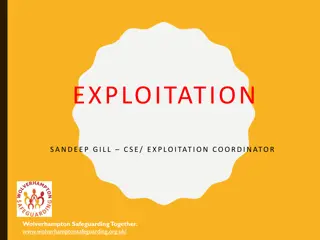
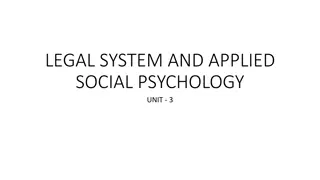

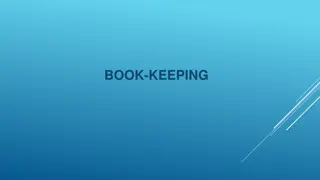

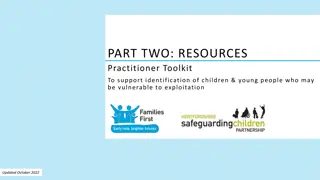
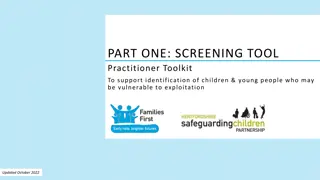

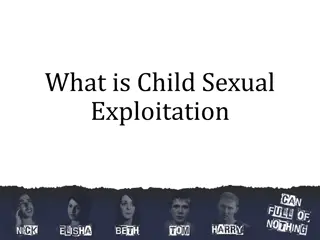
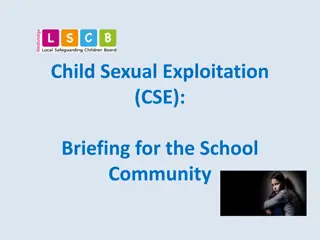
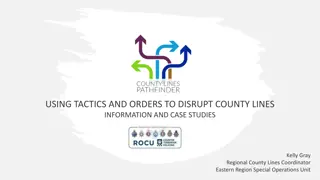
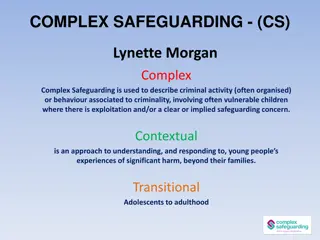

![Briefing on the Criminal Procedure Amendment Bill [B12-2021] to the Portfolio Committee on Justice and Correctional Services](/thumb/157093/briefing-on-the-criminal-procedure-amendment-bill-b12-2021-to-the-portfolio-committee-on-justice-and-correctional-services.jpg)
